Leather Advice
If you want the best advice and help in bringing your leather project to life, come in and see our experienced team at our huge West Melbourne store. There are thousands of hides to choose from, many of which are not listed here on our website.
We can help you select leather for any size project; from a bifold wallet to re-upholstering a luxury yacht to saddling a horse to a range of shoes.
In Brisbane, Adelaide, New Zealand or anywhere else in the world? You can still order online. Below is a short guide to help choose the best leather for your job.
Leather Sizing
Leather comes in a vast assortment of sizes and thicknesses. The leather you choose will depend on what you intend to use if for: you won't be able to make a horse bridle from the same leather you use to make a skirt.
We sell leather by the piece, but it is usually sold by area, generally measured in square metres (when sourced locally or from the EU), or in square feet (when sourced from the US or elsewhere). Product listings for leather have a sliding bar which will be centred on the average size for that leather type.
We measure leather thickness in millimetres, but you may come across guides that use ounces. See below for an Oz to MM conversion chart.
| Square metres | Square feet |
| 1 | 10.764 |
| 2 | 21.528 |
| 3 | 32.292 |
| 4 | 43.056 |
| 5 | 53.82 |
| Oz | MM |
| 1 | 0.4 |
| 2 | 0.8 |
| 3 | 1.2 |
| 4 | 1.6 |
| 5 | 2 |
| 6 | 2.4 |
| 7 | 2.8 |
| 8 | 3.2 |
| 9 | 3.6 |
Types of leather we sell
Bovine
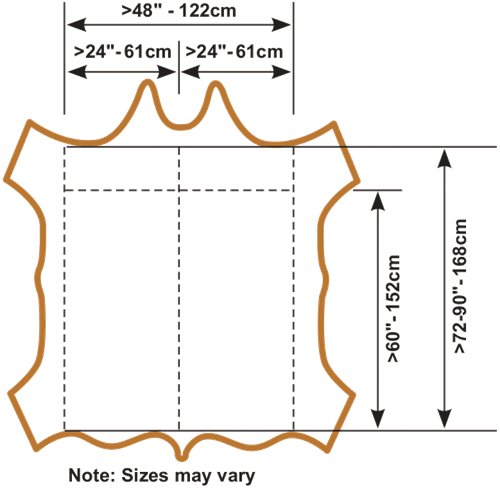
This is leather from cows, steers, and buffalo. It is sold either as a whole hide, or in a variety of cuts.
Full hide
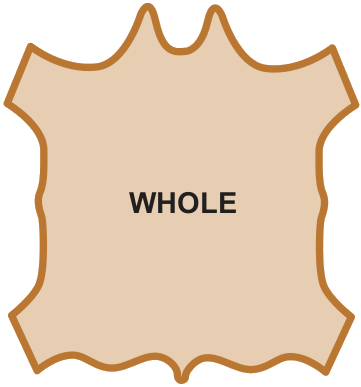
These are most commonly used for upholstery, where large single pattern pieces need to be cut. Typically they will be 1mm to 1.8mm thick, and soft.
Side

These are half a hide, cut down the spine of the beast. When chrome tanned, they are most commonly used for shoe uppers and bags. Vegetable tanned sides are usually used for saddles, harnesses, saddle bags etc. They come in a wide variety of finishes, and may range from 1mm to 6+mm thick.
Double shoulder
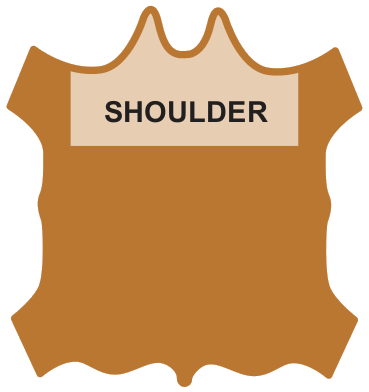
These are usually vegetable tanned, and are usually used for belts and general leathercraft projects. They range from 1.5mm to 3.6mm thick.
Double butt
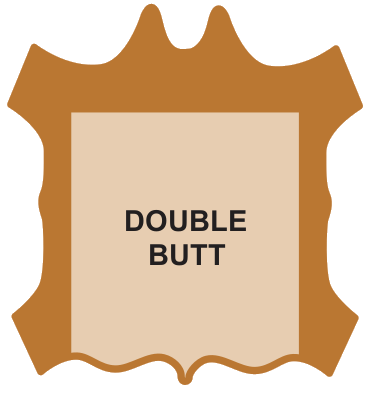
Being roughly square, double butts are most suitable when good yield and consistency are required for cutting belts. Usually vegetable tanned and available from 1.5mm to 5mm thick, with 3.5mm being by far the most popular thickness for belt making.
Single butt
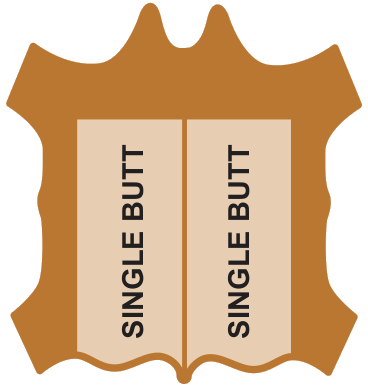
Vegetable tanned and roughly rectangular, these are usually used to cut into straps for horse bridles and stirrups, but are also often used for belts. Typically 3 to 5mm thick.
Back
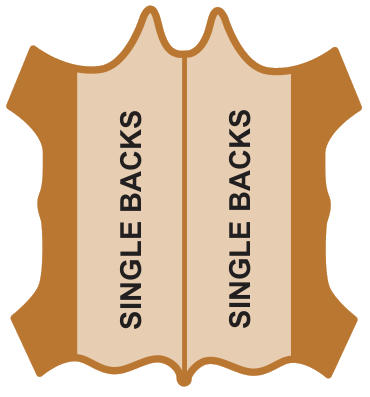
A long cut running the length of the beast close to the spine, these are used where length and strength are required. When vegetable tanned they are suitable for reins, harnesses and bridles. Alum tanned redhide backs are suitable for whip making, while heavy chrome tanned backs are commonly used for marine and industrial applications.
Belly
Vegetable tanned, these are softer, stretchier cuts, most suited to small leather goods where strength is not critical. 1.2mm to 2.1mm thick.
Bend
Vegetable tanned, bends are usually dense and stiff, being used most commonly for shoe soles. 3mm to 6mm thick.
Non-bovine
Non-bovine leather is most often sold as a whole skin, which vary according to the size of the animal.
Sheep / lamb
Sheep leather is soft and pliable, typically ranging from 0.5mm to 1.2mm thick. Available in a vast number of fashion colours and finishes, it is most commonly chrome tanned and used in garments. When vegetable tanned it is suitable for small leathergoods.
Kid
Usually slightly stiffer than sheep, kid leather ranges from around 0.5mm to 1mm thick and is used for light shoe uppers and small leathergoods when chrome tanned. When vegetable tanned it is often used for bookbinding.
Kangaroo
The strongest leather available for its weight, kangaroo is typically 0.7mm to 1.1mm thick. When chrome tanned it is suitable for shoe uppers and garments, while vegetable tanned kangaroo is perfect for plaiting and for making wallets.
Pig
This is most commonly used for lining, mainly in footwear. 0.5mm to 0.9mm thick, pig skins have a distinctive follicle pattern.
Exotic
From cane toad to chicken legs, snake and stingray, these leathers are most often used for feature panels on shoes and leathergoods and come in a wide variety of sizes and finishes.
